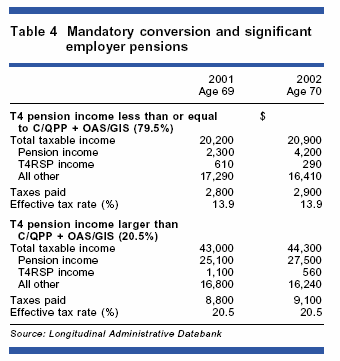High income saving When an RRSP is not enough
Post on: 13 Июнь, 2015 No Comment

RRSPs are simply one big tax game. The aim is to get at least the same (if not better) tax refund when you put money in, than you will be forced to pay when you ultimately withdraw from your RRSP or RRIF.
For those who make a high income – let’s say $300,000 in taxable income – RRSP contributions are great. Depending on the province, every dollar they contribute to RRSP’s effectively lowers their income by $1. This provides a lower tax bill of 39 to 50 cents. As long as tax rates don’t change, you are guaranteed not to lose the RRSP game because at worst, you will have to pay the same rate when you withdraw funds from your RRSP or RRIF, as you received when you made the contribution.
Therefore someone with a high taxable income should definitely contribute to their RRSP if at all possible. The challenge is that they often have more money that they would like to shelter but the RRSP contribution limit doesn’t allow for it.
For most people, they can contribute 18% of their earned income. In the case of the $300,000 income earner, that would translate into $54,000, however the limit comes in to play for them at just $23,820 for 2013.
In order for this person to improve their retirement planning, they have several options:
1) Maximize TFSA contributions. For a couple, you can add $11,000 to your TFSAs this year. In my estate planning work, especially when looking out 30+ years, we try and structure things so that TFSAs are the last pool of assets that are left in an estate – as they face no taxes (other than probate). TFSAs will become almost as important as RRSPs for retirement planning.
2) Make a portion of your taxable (non-registered) investments growth oriented, low income investments. These funds will create low taxes along the way, but should grow nicely over a long period of time, and can fund retirement without having to worry about being taxed on withdrawals. Examples of high growth, no dividend income companies might include: Adobe Systems, Priceline, Google, Constellation Software.
3) Use insurance as a tax sheltered alternative. If this person wanted to put $40,000 a year into their RRSP but is limited to under $24,000, one alternative option would be to put the other $16,000 into a life insurance policy on a parent or in-law. The ideal age for this type of insurance is 65 to 75. Assuming a parent is 30 years older than you, and passes away at age 90, then you will receive a non-taxable payment at age 60, just in time for your retirement. In many cases, the rate of return on this investment will be very good – 7%+ after tax equivalent – and the investment will help diversify your returns as the insurance is not correlated or tied to stock markets, real estate or bond markets. While some people feel that this is an inappropriate ‘investment,’ we have found that many parents are happy to help their children and ultimately their grandchildren in a way that costs them nothing other than a short health checkup.

4) Tax strategies such as flow through shares – which can come in two forms. Flow through shares are aimed at helping to lower the tax bill for those who have incomes in a top tax bracket. The first form is better known. In this case you invest say $50,000 into a flow through, you can get significant tax savings through a variety of investment credits. The risk is that you must invest these funds in highly volatile companies that are usually doing mining exploration. The second form is less well known, and is more conservative. It essentially takes away the investment risk, leaves you with a tax savings that is potentially smaller, but is guaranteed from Day 1.
5) Other strategies for high income business owners, incorporated professionals, and occasionally for key executives of a corporation, would include strategies called Individual Pension Plans (IPP) and/or Retirement Compensation Arrangements (RCA). These strategies are too complicated to address in detail here, but serve as tools to provide additional pension income to those who are restricted by the RSP contribution limits currently in place.
While RRSP contribution limits do impose some retirement planning challenges for those with a high income, a variety of good tax planning exists to provide some alternatives that might be even better than simply having more money going into your RRSP.
Ted Rechtshaffen is president and wealth advisor at TriDelta Financial, a boutique wealth management firm focusing on retirement and estate planning. tedr@tridelta.ca














